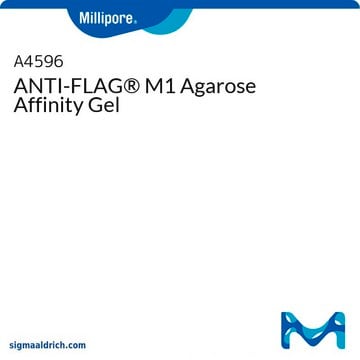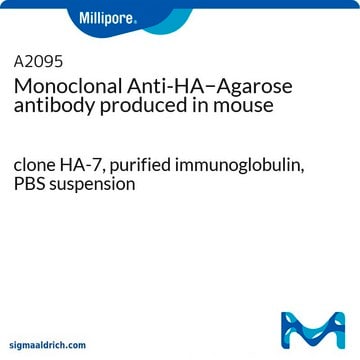推荐产品
生物源
mouse
品質等級
共軛
agarose conjugate
抗體表格
purified immunoglobulin
無性繁殖
HPC4, monoclonal
形狀
slurry
包裝
pkg of 1 mL (settled resin volume)
製造商/商標名
Roche
同型
IgG1, kappa
容量
2-10 nmol/mL binding capacity
儲存溫度
2-8°C
一般說明
蛋白C是维生素K依赖性血浆酶原,由凝血酶-凝血酶调节蛋白复合物通过蛋白水解裂解激活,形成抗凝酶。抗-蛋白C小鼠单克隆抗体(克隆号HPC4)可特异性结合含蛋白C凝血酶切割位点的表位序列,并已固定化。抗-蛋白C抗体识别编码蛋白C重链6-17个残基的12氨基酸序列(EDQVDPRLIDGK)。抗-蛋白C抗体/蛋白C表位复合物需要在钙离子存在的条件下形成。在Ca2存在下,该抗体高亲和与高特异性地结合天然人蛋白C或带有该表位的蛋白质中的这一序列。无论该表位位置如何(N末端、C末端或内部),重组融合蛋白均可进行高效结合。因此,这种独特抗体尤其适合纯化带蛋白C表位标记的重组融合蛋白。
抗-蛋白C小鼠单克隆抗体(克隆号HPC4)可共价偶联琼脂糖珠。在偶联反应中,4mg抗体和1ml珠子反应。
- 插入的蛋白C标记没有引入新的金属离子结合位点。Ca2+结合位点在抗体上。
- 蛋白C标记可任意掺入到融合蛋白的N端、C端或内部位置,而不会对抗体特异性有任何影响。
- 使用经济的钙螯合剂(如EDTA)或专用的蛋白C标记肽,可在非变性的温和洗脱条件下进行快速地免疫亲和纯化。
抗-蛋白C小鼠单克隆抗体(克隆号HPC4)可共价偶联琼脂糖珠。在偶联反应中,4mg抗体和1ml珠子反应。
特異性
抗蛋白C抗体识别编码蛋白C重链6-17个残基的12氨基酸序列EDQVDPRLIDGK。在Ca2存在下,该抗体高亲和与特异性地结合天然人蛋白C或标记该表位的蛋白质中的这一序列。无论该表位位置如何(N末端、C末端或内部),重组融合蛋白均可进行高效结合。
應用
抗-蛋白C亲和基质可用于:
在免疫沉淀或纯化之后,感兴趣的标记蛋白可以用于下列分析:
- 来自哺乳动物、细菌和酵母细胞提取物的蛋白C标记蛋白的免疫沉淀
- 蛋白粗提液来源蛋白C标记蛋白的亲和柱纯化
在免疫沉淀或纯化之后,感兴趣的标记蛋白可以用于下列分析:
- 使用抗-蛋白C抗体进行蛋白质免疫印迹分析(Western blotting)
- 银染色(或类似的蛋白染色)
特點和優勢
- 洗脱条件温和,采用EDTA等钙螯合剂。
- 对蛋白C来源的EDQVDPRLIDGK序列具有高特异性。
- 抗蛋白抗体与蛋白C表位的结合依赖于钙离子的存在。
- 无论融合的蛋白C标记位于N末端、C末端还是内部,融合蛋白均适合进行纯化。
- 适用于来自哺乳动物、细菌和酵母表达系统的细胞粗提液。
内容物
1.该抗体共价偶联琼脂糖珠,是由1ml微珠和1ml缓冲液组成的浆液。
2.在偶联反应中,每ml微珠与4mg抗体反应。
3.一个塑料柱,含顶端和底部盖子。
包裝
1个试剂盒包含纯化树脂(settled resin)和柱子
品質
每一批次的抗-蛋白C亲和基质都经过纯化能力测试,即从细菌粗提液中纯化转化细菌表达的蛋白C标记蛋白。抗体亲和柱可结合蛋白质印迹和/或银染色分析。
外觀
1 ml抗蛋白C亲和基质(settled resin)悬液含20 mM Tris、0.1 M NaCl、1 mM CaCl2和0.09%叠氮化钠(w/v);2 ml悬液相当于1ml柱床体积。一个塑料柱,包含顶端和底部的盖子。
分析報告
KD = 10–9 M,结合能力为2-10 nmol/ml亲和基质。使用含有蛋白C标记的β-半乳糖苷酶的全细胞细菌提取液进行纯化,产率为10.5 nmol纯化蛋白/ml亲和基质。
其他說明
仅用于生命科学研究。不用于诊断操作。
儲存類別代碼
12 - Non Combustible Liquids
水污染物質分類(WGK)
WGK 1
閃點(°F)
does not flash
閃點(°C)
does not flash
Arthur Günzl et al.
Eukaryotic cell, 2(3), 542-551 (2003-06-11)
In eukaryotes, RNA polymerase (pol) I exclusively transcribes the large rRNA gene unit (rDNA) and mRNA is synthesized by RNA pol II. The African trypanosome, Trypanosoma brucei, represents an exception to this rule. In this organism, transcription of genes encoding
Takumi Kamura et al.
Proceedings of the National Academy of Sciences of the United States of America, 100(18), 10231-10236 (2003-08-20)
The abundance of the cyclin-dependent kinase (CDK) inhibitor p57Kip2, an important regulator of cell cycle progression, is thought to be controlled by the ubiquitin-proteasome pathway. The Skp1/Cul1/F-box (SCF)-type E3 ubiquitin ligase complex SCFSkp2 has now been shown to be responsible
Mary Anne T Rubio et al.
Nature, 542(7642), 494-497 (2017-02-24)
Nucleic acids undergo naturally occurring chemical modifications. Over 100 different modifications have been described and every position in the purine and pyrimidine bases can be modified; often the sugar is also modified. Despite recent progress, the mechanism for the biosynthesis
Florian Bundis et al.
Cellular physiology and biochemistry : international journal of experimental cellular physiology, biochemistry, and pharmacology, 17(1-2), 1-12 (2006-03-18)
The weak inward rectifier potassium channel ROMK is important for water and salt reabsorption in the kidney. Here we identified Golgin-160 as a novel interacting partner of the ROMK channel. By using yeast two-hybrid assays and co-immunoprecipitations from transfected cells
Daniela Luz Ambrósio et al.
Eukaryotic cell, 8(7), 990-1000 (2009-05-12)
In trypanosomatid parasites, spliced leader (SL) trans splicing is an essential nuclear mRNA maturation step which caps mRNAs posttranscriptionally and, in conjunction with polyadenylation, resolves individual mRNAs from polycistronic precursors. While all trypanosomatid mRNAs are trans spliced, intron removal by
我们的科学家团队拥有各种研究领域经验,包括生命科学、材料科学、化学合成、色谱、分析及许多其他领域.
联系技术服务部门








